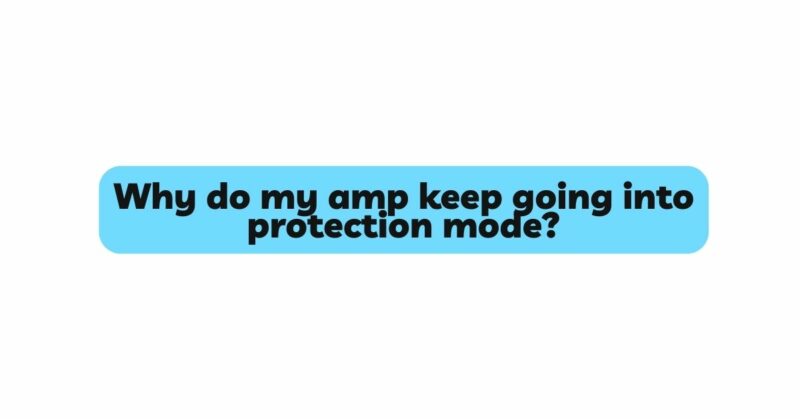Amplifiers are the backbone of any audio system, responsible for delivering clean and powerful audio signals to speakers. However, it can be frustrating when your amp continuously goes into “protection mode.” This mode is a critical safety feature designed to safeguard the amplifier and connected speakers from potential damage. When the amplifier detects an issue that could be harmful, such as overheating, short circuits, or impedance mismatches, it automatically activates protection mode, temporarily disabling the output. In this article, we will explore the common reasons behind this persistent behavior and provide practical solutions to resolve the problem, ensuring a seamless audio experience.
I. Understanding Protection Mode and Its Functionality:
Protection mode acts as a safety net for amplifiers, preventing damage to their internal components and connected speakers. When the amplifier’s protection circuitry detects an anomaly, such as excessive heat or current, it triggers protection mode. During this state, the amplifier stops its output, preventing any potential harm. Once the issue is resolved, the amplifier should return to normal operation.
II. Root Causes of Persistent Protection Mode Activation:
- Inadequate Ventilation and Overheating: One of the primary reasons an amplifier repeatedly enters protection mode is inadequate ventilation and overheating. Amplifiers generate heat during operation, and if not properly ventilated, the internal temperature can rise, triggering the protection circuit. Factors such as blocked ventilation grilles or placing the amplifier in a confined space exacerbate the problem.
- Impedance Mismatch: Speaker impedance mismatch is another common cause of persistent protection mode activation. Amplifiers are designed to work with specific speaker impedance ratings. If the speakers’ impedance is too low for the amplifier to handle, it can cause excessive current flow and trigger the protection circuit. Similarly, connecting speakers with different impedance ratings can lead to the same issue.
- Short Circuits: A short circuit occurs when the positive and negative speaker wire connections come into contact, creating a direct flow of current. This can happen due to damaged or poorly insulated speaker wires. When the amplifier detects a short circuit, it goes into protection mode to prevent further damage.
- Power Supply Issues: The power supply is crucial for proper amplifier operation. Fluctuations in voltage, power surges, or inadequate power delivery can cause the amplifier to enter protection mode. A weak power supply can lead to internal stress on components, triggering the protection circuit.
- DC Offset: DC offset is a condition where a constant voltage is present at the amplifier’s output, even with no audio signal. It can occur due to faulty components or improper grounding. The amplifier may repeatedly enter protection mode when it detects a significant DC offset.
- Faulty Components: Amplifiers consist of various electronic components, and if any of these components are faulty, it can trigger protection mode. Age and wear can also contribute to component failure, leading to frequent protection mode activation.
- Grounding Issues: Poor grounding can result in ground loops and electromagnetic interference, leading to unwanted voltage fluctuations that trigger protection mode.
III. Effective Solutions to Overcome Persistent Protection Mode Activation:
- Improve Ventilation: Ensure the amplifier has ample space around it and is placed in an open area with proper ventilation. Clean any dust or debris from the ventilation grilles to enhance airflow. Consider using external cooling devices, such as fans or heat sinks, to dissipate heat effectively.
- Verify Speaker Impedance: Double-check that the speakers’ impedance matches the amplifier’s specifications. Avoid connecting speakers with impedance ratings that are too low for the amplifier to handle. If using multiple speakers, calculate their total impedance when connected in parallel.
- Inspect Speaker Wires: Thoroughly inspect the speaker wires for any signs of damage or exposed wiring that could cause a short circuit. Ensure proper insulation and secure connections to prevent shorts.
- Monitor the Power Supply: Use a stable power supply with sufficient voltage and current capacity to ensure the amplifier receives consistent and reliable power. Consider using surge protectors or voltage regulators to safeguard against power fluctuations.
- Test with Different Components: Try connecting the amplifier to different speakers and audio sources to identify if the issue lies with the amplifier or external components. This step can help pinpoint the root cause of the persistent protection mode activation.
- Professional Inspection and Repair: If troubleshooting on your own doesn’t yield satisfactory results, consult a qualified audio technician or contact the manufacturer’s support for a thorough inspection and potential repair.
Conclusion:
Persistent protection mode activation in amplifiers can be a perplexing issue that disrupts your audio experience. Understanding the common causes, such as inadequate ventilation, impedance mismatch, short circuits, power supply issues, DC offset, faulty components, and grounding problems, is essential for effective troubleshooting. By implementing the suggested solutions and seeking professional assistance if necessary, users can overcome this problem and ensure their amplifiers operate reliably, providing outstanding audio performance without recurring protection mode interruptions.


